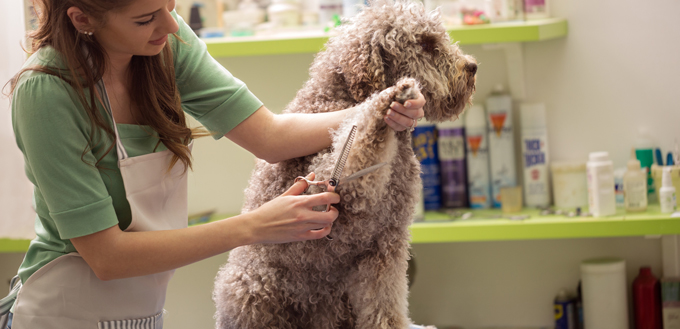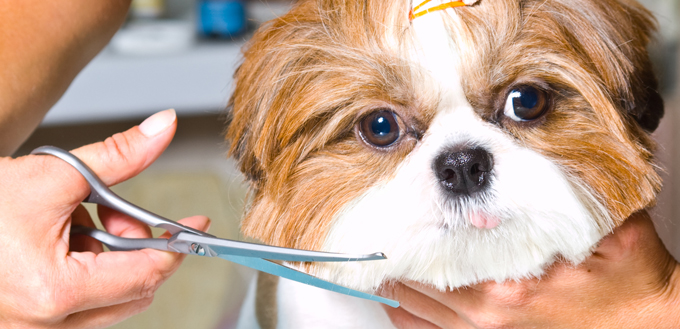How much do you spend getting your dog professionally groomed? Have you ever wished there was another way, one that didn’t involve letting your dog’s coat grow until they were a mix between a cotton ball and a carpet?
Well, luckily there is another way – giving your furry friend a haircut at home. Not only does it work out cheaper to take this approach, but it is also much easier than you probably think.
Follow these tips and you will soon be cutting your dog’s hair like a pro.
Perfect Preparation is the Key
As with most tasks being properly prepared is the key to success. Taking the time to collect the equipment you need, preparing the area that you are using, and preparing your pet makes a big difference to the cutting process and the overall outcome.

Other things you need to do before you start cutting are:
- Find out what your dog should look like – you don’t want to start out with an Old English Sheep dog and finish with a Poodle.
- Decide whether you are using dog clippers or scissors – consider the length of your dog’s coat, how much needs to be cut and your own confidence levels with each type of equipment before deciding.
- If you are using clippers choose the quietest ones possible to stop your dog from jumping and being nervous when you turn them on. Ensure the clippers are sharp and well-oiled before you start cutting.
- If you are using scissors, ensure they are sharp and that you have scissors that are suitable for the length and thickness of your dog’s coat. You also need smaller blunt ended scissors for trimming sensitive areas.
- Understand your dog’s coat – look at the direction of hair growth in different areas. See where the hair is thickest, where it is going to be most tricky to cut, and where there are obstacles to avoid (facial features, nipples, genitalia and claws for example)
Cutting with clippers
Clippers are ideal for short-haired dogs, or those who need a more extreme makeover. They are also ideal for owners who are nervous about their abilities. Using snap on guide combs not only ensures an even finish but provides your dog with some protection against shaking hands.
To get the perfect finish:
- Wash and brush your dog’s coat to get rid of tangles, mats and clumps of hair and reduces the risk of the clippers getting caught and pulling out hair.
- Work with your dog’s hair to produce a natural finish with no harsh lines.
- Work from their neck to their back leg on one side and then do the same again on the other side.
- Work slowly to avoid creating lines and reduce the risk of your dog becoming nervous and moving suddenly.
- Hold your dog gently while cutting, especially when trimming around sensitive areas.
- Talk to your dog while you are cutting, give them lots of praise.
- Consider using round ended scissors to complete trick areas such as paws and faces.
- Give your dog treats when you are finished
Cutting with Scissors
For long hair dogs, clippers may not be suitable, especially if you just want to give them a trim. In these cases, scissors are better. Generally, the cutting process is the same. But, there are a few significant things to remember if you want the finished cut to look professional.
- Ideally you need – straight grooming scissors for basic cutting, curved scissors for rounding off layers of hair, tinning shears for problem areas and to give your dog’s coat a more natural finish and safety, or rounded tip scissors for those delicate areas.
- Decide how short you want to cut your dog’s coat before you start cutting. Once you start, use your fingers as a guide to create a more consistent finish.
- Start at the front and work towards the back of your dog, leaving more difficult and sensitive areas until last.
- Use the thinning shears on areas that are thick, heavy or prone to matting.
- Work slowly and gently and avoid holding the scissors at a steep angle where the points are close to the skin.
- If you are cutting the hair short and are unsure how close to the skin you are, then keep a comb between the scissors and your dog’s skin to provide a safety barrier.

Remember, this is not a task that can be rushed. If your dog starts getting anxious or skittish, take a break Give them some fuss and a treat and then start again. With practice you will find the perfect time of day, when you dog is at their most relaxed and willing, and the process will be even easier.
Sources:
- Carol McCarthy, DIY Tips for Grooming a Dog at Home, PetMD
- Dr. Marty Becker DVM, Should I Clip My Dog or Leave His Coat Long?, Vetstreet
- Hair Comes Trouble: Why Pets Need Regular Grooming, ASPCA






